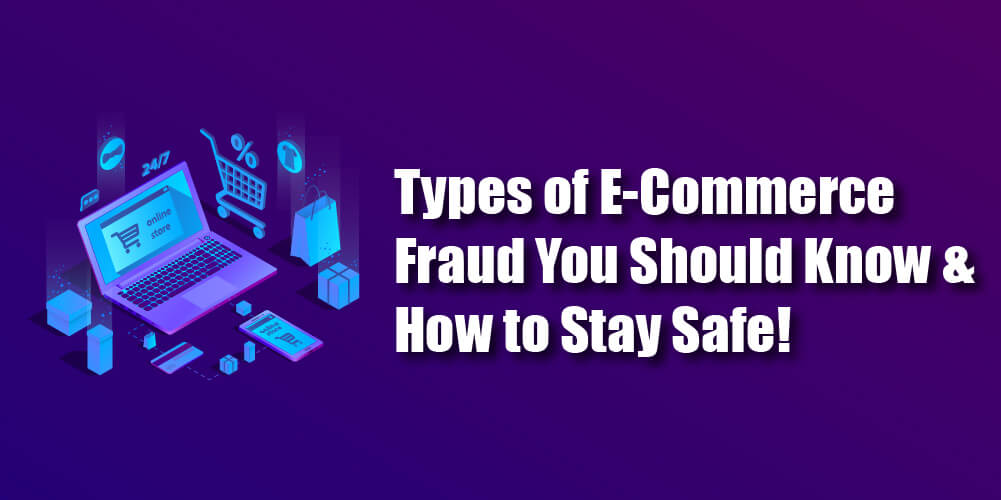The shift from traditional forms of shopping to online shopping presents a significant opportunity for eCommerce merchants in a space that has been accelerated by the ongoing Coronavirus Pandemic. Sadly though, as eCommerce continues to evolve, so does eCommerce fraud.

According to IDC predictions, global spending on cybersecurity is estimated to reach $133.8 billion in 2022. This means as a business, whether a small or a large eCommerce enterprise, you have no choice but invest in providing secure and customized online experiences for your customers. For starters, did you know there are different types of e-commerce fraud? Well. In this article, we will guide you through them and how you can protect your business.
Common Types of eCommerce Fraud
Credit card fraud
Credit card fraud has been named the curse of e-commerce because of the damage it causes. It is a common type of fraud that is driving many small businesses to bankruptcy. Imagine what happens when a crooked individual tries to purchase a product from your store using a stolen card?
Legally your business could even be held responsible. Sadly, this type of fraud is not exclusive to credit card payments; criminals are now using malware to command online banking logins via phone or computers.
Identity theft
Identity theft is a type of fraud where a person commits a crime by obtaining personal or financial information of someone else, assumes that an individual’s identity, and makes transactions. In E-commerce, this type of fraud happens when a fraudster proceeds to make an online purchase from your store maliciously using a different identity. Again, the stolen credit card is what is used to pay for the purchase.
Phishing
Phishing is another common cyber-attack that uses disguised email as a tool as an attack vector. The problem is that it is so easy to fall for phishing emails because most look like they are from a company you know or trust. Well, if John Podesta, Hillary Clinton’s campaign chair, got hacked through a phishing email, then you can understand how sophisticated or real phishing emails seem. For instance, you might get an email saying that there is a problem with your bank account, or you need to confirm some personal information. Because of the urgency and necessity dictated in the emails, most people find themselves clicking and dishing out information. As an eCommerce merchant, you are highly targeted because of the millions of personal data that you handle.
Refund Fraud
It is no brainer that a goof refund policy is one of the best tools merchants use to give their customers a feeling of security with their purchases. Sadly, fraudsters have taken advantage of the policy and are using it to defraud online businesses. This means, as an entrepreneur, you must be aware of the fact that not all returns are from honest shoppers with legitimate gripes.
Refund fraud occurs when a fraudster makes an overpayment using a stolen card on purpose then asks for a reimbursement. He/she will then offer an alternative payment for the refund to be affected. Sadly, because the card is stolen, you will have to deal with complaints from the original cardholder whose card was used to make payments.
Friendly fraud
Unfortunately, as a merchant, you are the one who suffers the most from this kind of scam. Friendly fraud happens when consumers make legitimate online purchases then disputes them. The fraudster might claim that the goods were not delivered, does not remember making the purchase, or cancelled the order but was still processed.
Remember, the goods were delivered, so as the merchant, you have reduced stock, probably incurred shipping costs but now have to appease the client to avoid the negative social press. Sad, right?
Interception Fraud
Have you ever received a customer’s request to change the shipping address or a sign-off request for goods delivered claiming the homeowner is not available? Well, some of these cases are a classic example of what interception fraud looks like. With this type of fraud, someone will create orders where the billing and shipping match the address linked to the card. They reroute or intercept orders to an address they pick the stolen goods.
Now that you are familiar with the different types of eCommerce fraud, below are measures that you can take to protect your store and customers.
Protecting against eCommerce Fraud
Secure your website
The best place to start is to secure your website, and the simplest way to do it is to use EV SSL Certificate. With an SSL certificate, the most sensitive and private data of your customers is protected from third parties who might try to steal their valuable information. It also enhances customer’s trust as it makes them feel safer and secure when permitting to use their personal and private information on your site. Make sure you also add security layers to your site like using Multi-Factor authentication, scanning your site for viruses, using hard to crack passwords, etc.
Have a solid tracking and shipping policy
This tip will help you deal with other types of fraud, such as friendly, refund, and interception fraud. Have a tracking and shipping mechanism that allows you to verify customers received their orders. Ensure the recipient of the product signs upon delivery. In essence, create a paper trail showing the product was ordered and delivered. Provide a way that customers can print pre-paid shipping labels to make sure there is a tracking code included on the label. It would help if you also were wary of refund fraud. Here are some of the ways to tackle the problem:
- Use tracking numbers on your shipment
- Consolidate your databases
- Invest in fraud-protection software
- Review your returns policy
Tip: Remember to train your employees to avoid common fraud
Require Security codes for all credit card purchases
Thanks to technology, modern credit cards come with an asset of three identifying numbers on their back. Ensure that these numbers are entered with every card purchase as standard practice. Additionally, work on your point of sale systems, train your employees, and stay vigilant all through.
Ask your customers to create strong passwords
Since fraudsters are looking for all ways to steal from you, ensure you ask them to create strong passwords. Keep educating them on how to stay safe.
Backup your data
Backing up your data is very important, especially in the case of attacks. You can store data to an external hard drive or cloud storage should you fall victim of a breach. s
Work with a third-party fraud prevention company
In addition to the above measures, you might want to hire a third-party fraud prevention company. Most of these companies have sophisticated fraud prevention technologies such as Geolocation, Device ID, Global fund blacklists, and IP proxy piercing that will help your store deal with fraud.
Final thoughts
From our discussion, it is quite evident that the success of your online store demands that you have a good grasp of the various types of eCommerce fraud and the knowledge to prevent them. As noted, e-commerce fraud evolves with eCommerce; this means we should expect other trends or different forms of cyber-attacks shortly. As an entrepreneur, you must recognize that the threat of fraud is real and prepare for it rather than feel sorry later!
Read More: How to Start eCommerce Business


